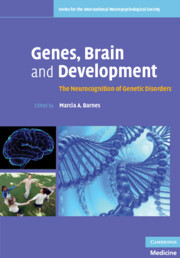Book contents
- Frontmatter
- Contents
- List of Contributors
- Preface
- Acknowledgments
- Section 1 Connecting genes, brain, and behavior in neurodevelopmental disorders
- 1 Intergenerational effects of mutations in the fragile X mental retardation 1 gene. Fragile X: A model of X-linked mental retardation and neurodegeneration
- 2 Autism: Genes, anatomy, and behavioral outcome
- 3 Development in spina bifida: Neurobiological and environmental factors
- Section 2 Genetic disorders and models of neurocognitive development
- Index
- References
3 - Development in spina bifida: Neurobiological and environmental factors
Published online by Cambridge University Press: 04 August 2010
- Frontmatter
- Contents
- List of Contributors
- Preface
- Acknowledgments
- Section 1 Connecting genes, brain, and behavior in neurodevelopmental disorders
- 1 Intergenerational effects of mutations in the fragile X mental retardation 1 gene. Fragile X: A model of X-linked mental retardation and neurodegeneration
- 2 Autism: Genes, anatomy, and behavioral outcome
- 3 Development in spina bifida: Neurobiological and environmental factors
- Section 2 Genetic disorders and models of neurocognitive development
- Index
- References
Summary
Introduction
Spina bifida myelomeningocele (SBM) is one of the world's most common disabling birth defects, yet, until recently, its genetic, neural, and cognitive phenotypes have been less systematically investigated than those of other neurogenetic disorders, including several of those featured in this volume. This chapter describes the findings from a large-scale multi-site study of more than 260 children with SBM between the ages of 7 and 16 years and over 160 children with SBM and their typically developing peers followed from infancy into school age that involves collaboration between the University of Texas Health Science Center at Houston, the University of Houston, and the Toronto Hospital for Sick Children.
The material is organized as follows: (1) What is SBM?; (2) The SBM genotype; (3) Relations between genotype and physical and neural phenotypes; (4) The SBM behavioral phenotype in relation to lesion level and environmental factors: intelligence, academic skills, and adaptive function; (5) Theoretical questions about typical and atypical development generated from studies of the SBM phenotype; (6) Longitudinal development in SBM from infancy through childhood and into adult life; and (7) Clinical care and intervention issues.
What is SBM?
SBM, a neural tube defect that affects the development of both spine and brain, arises in the third to fourth week of embryogenesis, and results in a failure of neural tube closure. The physical phenotype includes paraplegia of the lower limbs and neurogenic bladder and bowel function (Charney, 1992).
- Type
- Chapter
- Information
- Genes, Brain and DevelopmentThe Neurocognition of Genetic Disorders, pp. 53 - 82Publisher: Cambridge University PressPrint publication year: 2010



